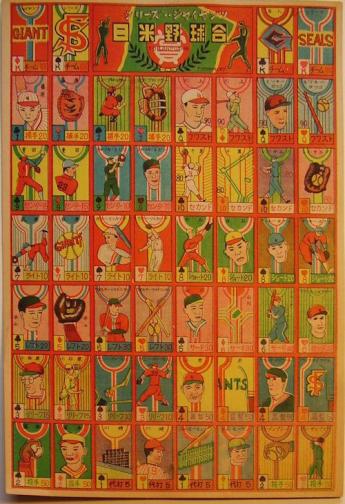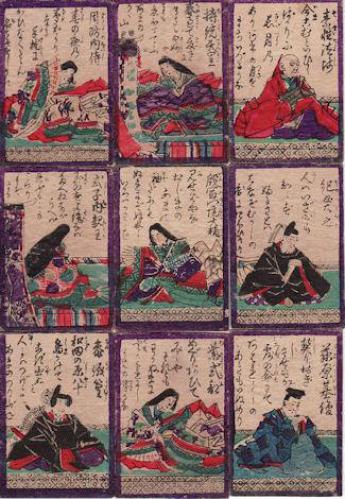Tip The Australian and New Zealand Association of Antiquarian Booksellers Asia Bookroom
Japanese Woodblock Ephemera

By Sally Burdon
For many people in the west mention of Japanese woodblock prints brings to mind the beautiful single sheet colour examples by artists such as Hokusai, Hiroshige and the many other artists of extraordinary skill working during the 18th and 19th centuries. Immense pleasure can also be gained from looking a little further and discovering the plethora of games, decorative papers, books, calendars, lists, news-sheets, maps, advertising, and ephemeral material of every kind that was published using woodblock printing methods during the Edo and Meiji periods.
The high rate of literacy in Japan 52 Japanese menko cards uncut on original sheet featuring San Francisco's Seals and the Japanese Yomiuri Giants. Showa 24. 1949 during the Edo period, rivalling that of Europe, was reflected in the wide variety of material published for both male and female audiences, adult and child alike. Perfect examples of these interesting uses of woodblock printing can be found in games of hyakunin isshu, sugoroku and menko.
Hyakunin isshu is the name by which both the classic Japanese 13th century anthology of waka poetry and a very popular card game are known. Hyakunin Isshu, which translates as One Hundred Poets, One Poem [Each] is just that, one hundred poems written between the 7th and the 13th centuries, each by a different poet. The Hyakunin Isshu showcases all of the most important poets from the late Heian period in Japan and was compiled by the famous 13th century critic and poet Fujiwara no Sadaie more often known as Teika.
The game, Hyakunin isshu based on this classic anthology, is played to this day particularly at New Year family get-togethers. Each set has two hundred cards - one hundred with the full poem and the other hundred with an image of the poet and a portion of the poem on it. To play this game successfully the player must demonstrate a deep knowledge of the poems together with the speed required to snatch the card before anyone else as soon as the poem is recognised. A highly intellectual version of the western card game called snap?
The cards themselves are fine examples of the skills of the artists involved. Very early sets were hand painted and later in the Edo period when woodblocks enabled mass production, colour printed sets became very popular. A set of hyakunin isshu, is a very beautiful mixture of the intellectual and game which is sometimes played almost as a sport. These karuta or Japanese cards make an important and beautiful addition to any collection of art, literature or sport - a combination which is rarely if ever seen in the west I would suggest.
Similar to Hyakunin Isshu sugoroku-e became very widespread thanks to the technique of colour woodblock printing. This board game not dissimilar to snakes and ladders, but with a much larger range of themes and styles, is also often played at Japanese family occasions such as New Year. Sugoroku as well as being a much loved game often focuses on educational themes such as correct behaviour for women, military successes, Buddhist stories, history and travel. The sugoroku-e were sold cheaply, folded in an attractive envelope which was sometimes designed by an artist more famous than the one who designed the sugoroku to be found inside the packaging. Proof indeed that marketing was a flourishing art in Edo Japan! Famous artists such as Hiroshige made sugoroku but unfortunately, like most well loved but ephemeral items, the number of sugoroku to be found today is far fewer than those originally published.
Menko a game with origins in the Kamakura period (1185 - 1333), is published in sheets. The menko circles, squares or rectangles published on these sheets were designed to be backed onto thicker paper, cut out and used individually. A perfect reflection of popular culture, particularly as it appealed to small boys, menko themes covered a very wide variety of subjects such as sumo, the Seven Lucky Gods, warriors, and heroes of all sorts from sport to comics. Woodblock examples of menko are now very rare due of course to the requirement to cut the sheets to play the game. Menko continued to be published by photomechanical means after woodblocks were abandoned for mass market material and a modern example is included in the accompanying illustration.
Asia Bookroom has a growing collection of these Japanese games together with a variety of other examples of Japanese woodblock printing for sale. These fascinating and relatively inexpensive ephemeral pieces, with work by some of the world's best known artists included in their midst, constitute a beautiful and intellectually engaging area in which to build a collection. Also available from Asia Bookroom are many books on the art of Japanese woodblock printing. We particularly recommend: Japanese Popular Prints. From Votive Slips to Playing Cards - Rebecca Salter. One Hundred Poets, One Poem Each. A Translation of Ogura Hyakunin Isshu. Japanese Woodblock Prints - Andreas Marks
The article is one of the highlights of BookFare 2 (July 2011), the recently published newsletter of the Australian & New Zealand Association of Antiquarian Booksellers (ANZAAB). It is presented here by permission of ANZAAB President Sally Burdon (Asia Bookroom) and newsletter editor Jörn Harbeck.
>>> Click here to read BookFare 2 and to subscribe to further issues

